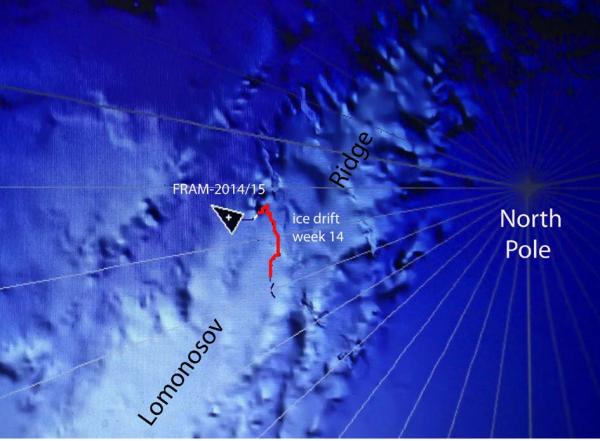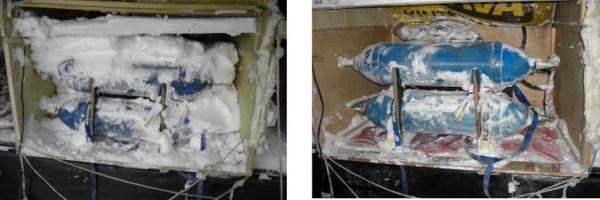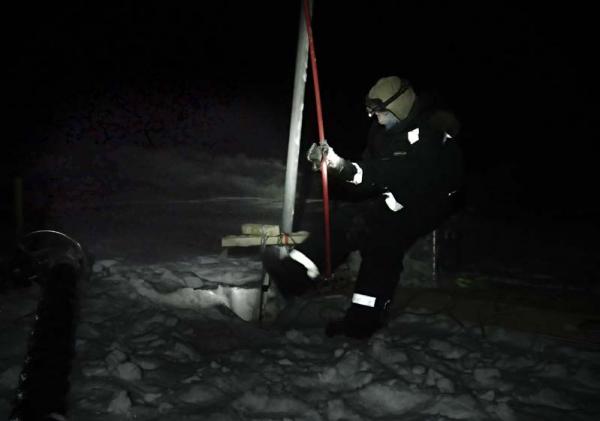
(01 - 08 Dec. 2014)
Ice drift
The ice camp moved about 27 nautical miles (50 km) during the week (Fig. 1). During Monday through Wednesday, the drift was due east and later turned south. The driving force was an elongated high pressure cell which extended from Franz Josef Land to past the New Siberian Islands. Peak pressures exceeded 1050 hPa. After Wednesday the axis of this cell shifted and went from the East Siberian Sea to the Beaufort Sea. The major event of the week was a low pressure coming north from the Canadian Arctic Islands which gave us winds over 35 knots all Monday, Tuesday and into Wednesday. Gusts were over 40 knots and drove the ice fields to a speed of 0-6 knots on Tuesday. Winds were calm (<12 knots) during the last part of the week.

Fig. 1 Drift track of FRAM-2014/15 over Lomonosov Ridge during week 14
Sea ice dynamics
Only small relative ice movements affected our neighborhood this week. Exceptions were some minor ridging in the old camp area and widening of the crack by 0.5 meter between our camp and the temporary depot area 300 meters away.
Camp life
The low pressure brought in warm air at high wind speeds. Temperatures on Monday and Tuesday were warmer than - 10° C with a maximum of - 3° C on Monday. Temperatures on Wednesday through Saturday were - 22° C to - 25° C and on Sunday we were back to - 30° C.
This is the third week spent on logistics in order to get back on track at the new camp location. We have been moving food, fuel and equipment. The new work space is half finished and the hydro hole near completion. Start-up after a break is most often not straight forward as indicated by the following example. We opened the enclosure made over the compressor to keep it warm with the expectation that we only needed to turn on the heat. The whole box was now packed with hard windblown snow - a result of the snow storm at the beginning of the week (Fig. 2). To get it ready is a couple of days of thawing after most of the snow is removed. A hydraulic hose is like a steel rod, do not try to move anything before you have used the heat gun to warm the essential parts.
The full moon came over the horizon on 1 December, but was not visible to us until the 5th due to overcast. The light of the full moon makes it possible to see the ice landscape and walk around without a head lamp. However, the lamp is needed for any work to be done. The beauty of the ice surface in moon light is awesome.

Fig. 2 The snow filled compressor enclosure (left). The diver compressor is located behind the blue air bottles in the foreground (right).
Science
This week, the following suite of continuous measurements has been unaffected by the ice activity:
Bathymetry and sub-bottom profiling:
- two active autonomous echo sounder buoys reporting to shore via Iridium
Oceanography:
- two Aanderaa current meters at 800 and 1050 meter depth, respectively.
- thermistor string recovered on Wednesday
Atmosphere:
- Aanderaa weather station recovered on Thursday
The priority this week was to re-establish camp facilities and made it unrealistic to carry out any additional science tasks.
The thermistor string was now about 7 meters from the main shear zone. During ice ridging, parts of one ice floe often gets thrust under the other as was the case for the ADCP site mentioned in our last report. We feared this could happen at the site of the thermistor string and decided to recover the string. A hole was drilled next to the chain and we were able to hook on to the chain under the ice and recover all the gear safely except the weight (Fig. 3). The thermistor data loggers have records of the microstructure of the temperature field within the upper 300 meters below the ice for almost four complete crossings of the Lomonosov Ridge. We are awaiting instruction to download the data before redeployment.
On Thursday, the weather station was moved as the field of pressure ridges were about 15 meters from the site. Unfortunately, the wind cross was broken in the process. A replacement is expected with the planned air drop before Christmas.

Fig. 3. Recovering the thermistor string. The supporting chain was hooked under the ice by a shackle attached to a strong rope taped to the end of the red pole. The front of the pressure ridge is barely visible in the dark background.
Our visitor, the un-named polar fox continues to keep us company by overseeing our outdoor activities. He has started to move in on particular items of his/hers liking. First a green cargo strap disappeared, then a second one was attempted, but abandoned and recovered by us. Next, a yellow and red cutting head to our 10 cm ice auger disappeared. We suspect it is a male fox from the way the animal urinates. The name of the fox is still not settled and new suggestions are; " Prestrud's sendebud" and "Inspektør Snusen".
Air drop by the Norwegian Air Force
There was no multi-year sea ice spotted from Polarstern at the time of our initial camp deployment. The repeated disruptions by sea ice deformation in the domain of first year ice, force us to change strategy in terms of ice camp logistics. Ice hangars may be a good idea on stronger multi-year sea ice floes, but less so on weak first year ice. The Operational Headquarter of the Norwegian Air Force has generously allocated an Orion flight to the FRAM-2014/15 ice camp if their flight schedule and weather permit. The supply mission will take place either before Christmas or after 5 January. The purpose is to bring out work tents to provide for swifter and safer camp relocation and serve as a general safety contingency. The air drop also includes other minor essential items and spare parts.
Life is treating us well.
Yngve Kristoffersen & Audun Tholfsen
Daily reports
Monday 01 December.
Position: 88° 33.9' N, 73° 32' W, temperature - 4° C, air pressure 1012 hPa, wind 30 knots from SE. Ice drift 0.5 knots towards west. No outside work today.
Tuesday 25 November..
Position: 88° 08.38' N, 78° 37' W, temperature - 11° C, air pressure 1028 hPa, wind 37 knots from SE. Ice drift 0.6 knots towards west. Stayed inside most of the day, but picked up radiation flux instruments and battery box and stored at new camp site. Minor ice ridging in old camp area.
Wednesday 26 November.
Position: 88° 36.6' N, 84° 08' W, temperature - 23° C, air pressure 1038 hPa, wind 28 knots from ESE. Ice drift 0.3 knots towards west. A new crack has opened 0.5 meter half- way between the new and old camp area. The thermistor string is now 7 meters from the major zone of ice ridging and we mounted an attempt to get it out. Drilled a hole next to the frozen in upper chain and was able to hook on to it and recover the 300 meter string safely. Lost the weight at the end because of a corroded shackle. Will await instruction on how to download
the data before redeployment. Moved 6 Zarges boxes of food from the old camp to the new.
Thursday 27 November
Position: 88° 34.7' N, 85° 58' W, temperature - 24° C, air pressure 1043 hPa, wind 8 knots from the E. Ice drift 0.1 knots toward south. Moved two large wooden boxes and six Zarges boxes of food to the new camp area and moved five fuel bladders across the recent crack at our temporary storage area. The weather station was now 15 meter from a pressure ridge and was rigged down and moved to the new camp area.
Friday 28 November.
Position: 88° 31.5' N, 84° 09' W, temperature - 22° C, air pressure 1025 hPa, wind 8 knots from NE. Ice drift 0.2 knots towards south. Repair work on the portable diesel pump. Mounting new hydrophone for the seismic measurements - we have lost two hydrophones to the ice, but still have two spares. Audun started to build new work space for the seismic and geological work, and work on making a new hydro hole was initiated. Ice thickness is 1.5 meter. The half- way crack widened another 0.5 meter.
Saturday 29 November.
Position: 88° 27.3' N, 84° 17' W, temperature - 23° C, air pressure 1014 hPa, wind 15 knots from the E. Ice drift 0.2 knots towards SSE. Work on the new work space and hydro hole continued. Found the compressor compartment totally packed with windblown snow. Cleared out the snow and put heat on.
Sunday 30 November.
Position: 88° 24.6' N, 84° 14' W, temperature - 30° C, air pressure 1013 hPa, wind 9 knots from the NE. Ice drift 0.1 knot towards the south. Work on the work space and hydro hole continued. Moved a fuel bladder from the old camp area to the new.

